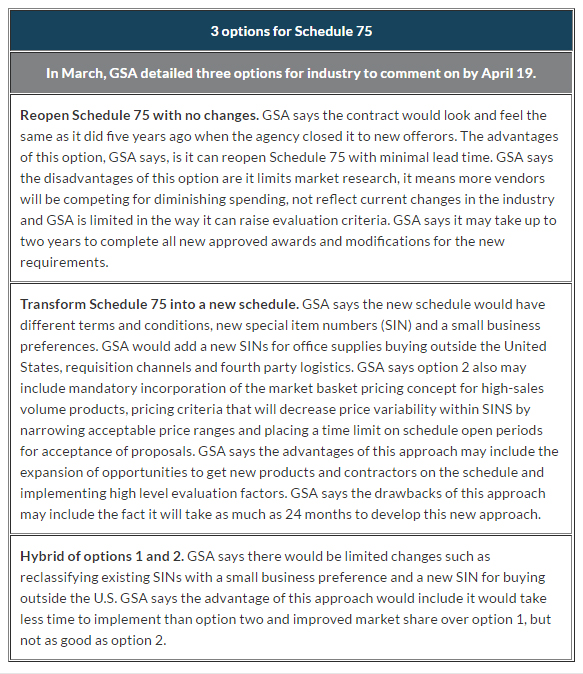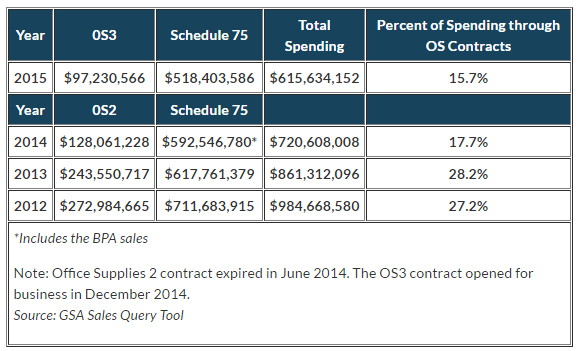
Exclusive
Strategic sourcing: Evolving or devolving?
The General Services Administration is soliciting industry input on how to buy office supplies differently through the multiple award schedules. Some in industr...
The Obama administration’s approach to better control federal spending on office supplies has fallen short of expectations and, many in industry believe, damaged the supply base.
So five years after closing down Schedule 75 to new vendors, the General Services Administration now plans to reopen the multiple-award contract.
GSA announced in March that it’s asking for industry feedback on three options for reopening Schedule 75 as part of its market research.
- Reopen Schedule 75 with no changes.
- Transform Schedule 75 into a new schedule with different terms and conditions, new special item numbers and a small business preference.
- Hybrid approach to options 1 and 2.
GSA says comments on the three options are due by 3 p.m. on April 19, and then it will hold an industry day later in the year to detail the input and its path forward.

Greg Hammond, GSA’s Federal Acquisition Service’s regional commissioner for the Northeast and Caribbean Region, which runs the office supplies contracts, said discussing how best to reopen Schedule 75 is part of a natural progression from strategic sourcing to category management.
“The decision to possibly reopen Schedule 75 wasn’t driven by the expectation that office supplies strategic sourcing wasn’t operating to plan,” Hammond said. “It’s about looking at the next strategy for the future.”
In fact, Anne Rung, the Office of Federal Procurement Policy administrator, said many times over the past year that strategic sourcing is one tool of category management, and category management is not just a new name for strategic sourcing.
Many in industry, however, are calling this about-face by GSA a recognition that its approach to strategic sourcing was doomed from the beginning.
“Realistically, I’m happy that GSA realized there is a need for a supplies commodity category within the multiple award schedules program still, and that Federal Strategic Sourcing Initiative (FSSI) wasn’t going to solve all their needs,” said Rick Vogel, associate government sales manager for Coast-to-Coast Computer Products, a Schedule 75 contract holder. “It’s a shame GSA may be putting themselves in a precarious position because there were lots and lots of good-sized organizations that basically had to close down their government operations or sell off as result of the closure of Schedule 75. I don’t know what that means to industry or those companies, and I don’t see them jumping back in to the marketplace, and I see a lot of small businesses that were hurt by the closure of Schedule 75.”
Vogel questioned why GSA closed Schedule 75 to new vendors in the first place.
“If the whole point of closing it was FSSI was going to take care of [all federal office supplies needs] and we don’t need Schedule 75 anymore and it was duplication, so why are they now changing their stance and saying it’s no longer duplication?” he said.
White House can’t change buying habits
The White House and GSA have been struggling to get agencies to change their buying habits for office supplies for almost a decade.
GSA, under the direction of the OFPP, first made awards under the Office Supplies 1 (OS1) contract in August 2007. After that contract failed to gain much traction, the Obama administration tried again with the OS2 contract, awarding to 15 companies, including 13 small ones, in 2010.
While OFPP didn’t mandate the use of OS2 or OS3, agencies did so through memos to contracting officers. OS2 started to take off with spending reaching a high of $272 million out of almost $1 billion in 2012 on office supplies governmentwide.
In those first two years, agencies moved to OS2, spending a higher percentage of money on office supplies each year. OS2’s market share of all office supplies spending increased from 27.7 percent to 28.2 percent between 2012 and 2013, while overall spending on these goods and services decreased governmentwide.

But OS2 expired in 2014 and GSA faced a series of bid protests that delayed the follow-up contract, OS3. That delay opened the door for agencies to go back to Schedule 75, but with a smaller number of contractors to buy from.
Even after the Government Accountability Office resolved the bid protests of OS3, agencies didn’t return to use the strategic sourcing vehicle at the same rate. GSA saw spending drop to $97 million in 2015, down from $124 million the year before on OS3.
Over the last three years, agency spending on the office supplies strategic sourcing contract dropped by more than $175 million — or 64 percent — between 2012 and 2015.
Peter Han, director of the acquisition center in GSA’s Federal Acquisition Service’s Northeast and Caribbean Region, said agencies are getting better prices under OS3 despite spending less overall money.
“When we compare our OS3 pricing to Schedule 75 pricing, it’s about 28 percent less,” Han said. “OS3 has about 85 percent of every sale going to a small business and that compares to 75 percent under OS2 so we are seeing an increase of small business spend, and that’s one of our goals.”
Additionally, he said during the first 11 months of OS3 as compared to the same period of time under OS2, agencies have spent $2 million more under the new contract.
Even though spending under Schedule 75 also continued to decrease, down to $518 million in 2015 from $592 million in 2014, the vast majority of agencies were going to that schedule to spend most of their money for office supplies.
“If you look at the numbers so far at least where OS3 is concerned, agency customers prefer Schedule 75, and while it’s a little broader in scope, most of it is office supplies,” said Larry Allen, president of Allen Federal Business Partners, who works with several companies on Schedule 75. “OS3 sales have fallen off from OS2 and there are reasons for that. Agencies know they can put their own market basket of items together using a blanket purchase agreement against the schedule, rather than having to use the one-size-fits-all that is what controls OS3. If I know I have some specific products that I use more than others and they aren’t in market basket, I can do a BPA and get what I need. Schedule 75 contractors also are advertising saying they can do a better deal than OS3.”
GSA gave agencies permission to create BPAs after OS2 expired and OS3 was tied up in bid protests.
Allen and others say that ability to create BPAs expedited the decline of OS3.
“Now agencies like those BPAs and that is driving revenue. So the message to GSA is if you want to remain relevant in office supplies you need to have a robust Schedule 75 offering in addition to OS3,” he said.
24 percent fewer vendors on Schedule 75
But the question is whether GSA still can have a robust Schedule 75 given the impact the strategic sourcing initiative had on some suppliers.
Unlike many of his former competitors, Vogel said Coast to Coast survived the strategic sourcing effort by expanding its offerings and moving business to the IT schedule.
But he said Coast to Coast lost as much as $10 million a year in revenue from the Office of Federal Procurement Policy’s, which all but mandated the use of the Office Supplies 2 and 3 contracts. A majority of the agencies sent out memos to their contracting officers requiring the use of the office supplies strategic sourcing contracts, even if Schedule 75 was cheaper or a better value.
Other vendors weren’t as lucky. GSA says the number of vendors under Schedule 75 dropped to 340 in February 2016 from 450 in 2012 — a 24 percent reduction.
Vogel said one example of a vendor that went out of business was Adams Resource Marketing. Back in 2012, Bonnie Whittaker, vice president for federal sales, told Federal News Radio sales under Schedule 75 dropped by 30 percent and the company laid off five employees in sales. Whittaker and others rang the alarm bells about the short and long term impacts strategic sourcing would have on the industrial base around office supplies.
Sam Bornstein, a professor of accounting and taxation at Kean University’s School of Business in Union, New Jersey, and a partner with the firm Bornstein and Song, has been an outspoken critic of all federal, state and local government strategic sourcing efforts.
“Strategic sourcing is a recognized best practice in the private sector which promotes efficiency and cost reduction. One of the key precepts is based upon leveraging to attain cost savings. This process involves picking winners and losers among the vendors doing business with the private entity,” Bornstein said in an email to Federal News Radio. “Obviously, the private sector entity is not concerned with the plight of the losers, but when strategic sourcing is applied in the public sector a whole new set of factors must be addressed. In the government sector, there should be concern for the impact on the non-winning vendors because the first rule of government is to do no harm.”
Bornstein said instead, the government should perform a cost-benefit analysis to evaluate whether the costs exceed the benefits.
“Unfortunately, GSA has ignored the Small Business Administration’s call for the need for a cost-benefit analysis of the FSSI, which calls into question whether FSSI is doing more harm than good,” he said.
SBA found in April 2014 that GSA did not conduct an adequate assessment of the impact the Office Supplies 3 strategic sourcing vehicle would have on small businesses. The Small Business Act requires agencies to determine whether new contracts would have a negative impact on small firms.
Bornstein said he conducted research to gauge the impact of the FSSI between 2010 and 2013. He said the results showed 88 percent of Schedule 75 holders said OS2 was detrimental to their business, 99 percent said they lost government sales and there was “significant” job loss as a result.
Growing concerns about expiring contracts
Kevin Paul, president of KPaul, a service disabled veteran-owned small business that provides IT and office products to the government, also was one of the vendors that survived by diversifying over the last five years.
“We were on Schedule 75, but it wasn’t renewed when it expired,” he said. “We applied for OS3 and lost, filed a protest and lost. The strategic sourcing initiative did have an impact on our business. We went from selling toners to the Veterans Affairs Department hospitals to VA being mandated to buy the same thing from Staples. We have a direct email from the VA customer saying that they can’t buy form us anymore and required to buy from Staples.”
Paul said his business dropped between 20 percent and 30 percent because of the strategic sourcing mandates.
Allen said reopening Schedule 75 couldn’t come soon enough as he’s getting a lot of calls from vendors who’s contracts are expiring in the next year or so and are wondering if they will lose their spot on the vehicle.
“The longer you keep Schedule 75 closed to new offerors, the more companies drop off. That reduces the number who can participate on the schedule, which also reduces the appeal of Schedule 75 to federal users, who right now really like that option,” he said. “There is a lot of pressure from outside the agency to have the OS3 contract succeed. GSA’s response has been to try to drive prices on OS3 even lower.”
The desire for lower and more consistent prices for office supplies was one of several of the Obama administration’s goals when it reinvigorated strategic sourcing in 2009.
Joe Jordan, the former OFPP administrator and now president of FedBid, said there were four main objectives with strategic sourcing when the administration re-energized the concept: reduce contract duplication, increase standardization of terms and conditions, reduce pricing and increase the percentage going to small businesses. He said overall strategic sourcing has been successful across all four areas.
“We are seeing the evolution of strategic sourcing. There is opportunity to create a win-win-win by having a larger number of small businesses participate while still taking advantage of better pricing,” Jordan said. “The theory was, and it still makes lot of sense, take the largest spend base in the world on a commodity item like office supplies, which are not bought in a best value competition, but in a lowest-price technically acceptable (LPTA) approach, and drive hard for best prices and let agencies order off it. The problem is when all the up-front terms and conditions are worked out, businesses have to factor in the risk that their costs will go up so if they are giving the government their best price for a five-year period, that might not reflect what best price is 6-to-12-to-18 months from now.”
Category management is the next step
Jordan said the answer is category management where the focus isn’t on up-front negotiations of price, but giving agencies data to understand the market better.
“Then instead of winnowing eligible competitors and driving the price down, expand and focus on the criteria for the commodity, and then capture best pricing at task order level,” he said. “I continue to believe that strategic sourcing efforts and office supplies was on the vanguard and were successful, but it never was intended to stand as-is forever. There was always the intent to refresh the model, whatever the model is will benefit from the core principles in the strategic sourcing effort and agencies have benefited.”
GSA’s Han said Schedule 75 and OS3 are not and never have been in competition with each other.
“We see it as more spend that comes through managed contract the better,” he said. “As long as our customer agencies are not creating their own vehicles, we are taking a holistic approach to these commodities.”
But for Vogel, Paul and many others, it took the administration too long to realize how best to achieve the goal of better buying. Vogel said it wasn’t by limiting competition, but rather by promoting best prices at the task order level.
“We wish GSA would move away from strategic sourcing. The way it works in the commercial marketplace is not directly relative to the government marketplace,” Vogel said. “The government is constantly trying to emulate industry when it comes to strategic sourcing, but there are things not being considered like how much did the Department of Labor spend on unemployment insurance for those companies that laid off workers because of this policy. When the government considers those impacts, I’m not sure OS2 or OS3 saved money.”
Copyright © 2024 Federal News Network. All rights reserved. This website is not intended for users located within the European Economic Area.
Jason Miller is executive editor of Federal News Network and directs news coverage on the people, policy and programs of the federal government.
Follow @jmillerWFED




